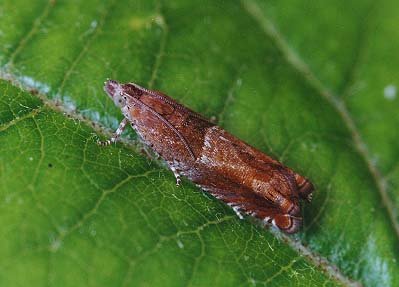49.248 BF1139
Nut Bud Moth Epinotia tenerana
([Denis & Schiffermüller], 1775)
Wingspan 12-16 mm.
Common and widespread throughout Britain, frequenting woodland and damp areas.
The adults fly from dusk onwards and are on the wing from July to early October. They can sometimes be found resting on the foliage of the foodplants during the day, which is how the adult shown was located.
The larvae feed on hazel (Corylus) and alder (Alnus glutinosa), feeding at first on the catkins and later burrowing into the leaf buds.
Larva: (description Ian F. Smith)
Foodplant: Oct.- March in Alnus and Corylus unexpanded catkins. March- May in leaf buds. Hole in bud may be capped with leaf fibre.
Early instar
Length: 2mm early March, 5mm mid March.
Head: Black.
Prothoracic shield: Black with broad greyish anterior border.
Thoracic legs: Black.
Body: Greyish white.
Spiracles: Peritreme dark brown.
Pinacula: Tiny black pinpoints, except abdominal segment 9 which has large single dorsal pinaculum and a large subdorsal pinaculum on each side, coloured as anal plate.
Setae: Colourless transparent.
Anal plate: Light brown.
Prolegs: Coloured as body, anal proleg with large pinaculum coloured as anal plate.
Late instar
Length: 9.5mm early April.
Head: Brown. Frons edged black. Capsule outlined by subventral thick black band from edge of mouthparts through the stemmata to the posterior where it outlines the edge with a thinner black line. A second parallel short black ventral band runs from the mouth parts to the posterior of the capsule.
Prothoracic shield: Brown with whitish anterior border and a broad blackish posterior border. Divided by whitish grey medial line.
Thoracic legs: Brown with black tibia and basal edge of coxa edged black at anterior.
Body: Shagreened translucent grey or yellowish green, showing dark reddish gut in anterior half of abdomen.
Spiracles: Peritreme dark brown.
Pinacula: Smooth shining grey with fine black setal spot. Large dorsal pinaculum on A9 coloured as anal plate centrally with periphery coloured as other pinacula.
Setae: Transparent, yellowish basally, colourless distally.
Anal plate: Yellowish.
Prolegs: Yellowish white, crochets red-brown. Pinaculum on anal proleg coloured as anal plate.
Rearing
Keep catkins in small airtight pot. Renew if go mouldy. In March provide Corylus buds on twigs stood through tight fitting holes in lid of a pot of water (cut Alnus does not keep well in water). Keep in ventilated cage with a few dead leaves for pupation.

 UKMoths
UKMoths 





